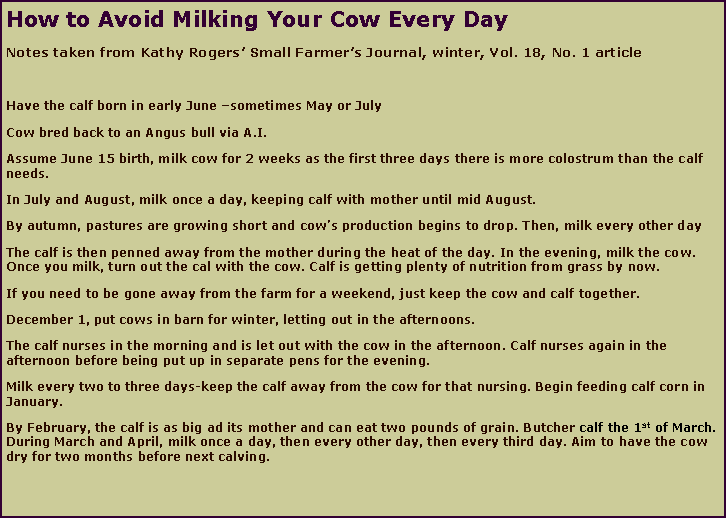


|
Lucy is a sweetly tempered cow and a very protective mother. Here she is with “Little Moo”, her bull calf calved in August 2009. She is a registered American Jersey. Her sire is Sunset Canyon Mecca-ET, her dam is PR Berretta Hess We used the following “milk share” program: The calf nursed the first day. By the second day, Lucy was lightly milked two times a day, that means about 5 minutes with a bucket milker for four days. The colostrum can be saved and frozen in sanitized plastic milk jugs. On the fifth day, time of milking was increased slowly so that by one month after calving, it has been increased to 8 minutes. The calf will strip out the udder so that the risk of mastitis is lowered. |

|
By the second month, Lucy was milked once a day in the evening. She was fed 1 flake of alfalfa hay, 2½ pounds each of dairy ration and alfalfa pellets 2 times a day. The hay ration was increased to two flakes during December thru March, that is until Spring grass began to show. Little Moo would stay in his stall during the day, but Lucy could see her baby. Once milked, the two were united. Once the Little Moo began eating hay/grass, I switched to milking mornings, because food and water could be given while penned for the evening and morning milking worked best for us. The calf soon leaned to go into his own pen while Lucy went to hers for milking. This is how it was accomplished: The two stalls were separated by metal gate. Lucy’s milking parlor gate would be opened and she and Little Moo would enter. Grain was put into her food bin. As she put in the head to eat, the stanchion would be engaged. While she was eating, Little Moo would either get moved out of her stall by us, or have the milking stall outside door closed before he reached it and directed into his stall, or have the dividing gate between the stalls swung such that he could get moved into the adjoining stall. For the first weeks, it’s best to have two people helping to separate the calf from the mother. A calf soon learns to go into its stall while the dam is being milked. If we were to be gone for a day, that is she’d not be milked one day, the grain would be cut in half and then upon our return, slowly increased back to the original amount. Here is a typical situation: Milk Friday morning with grain ration and pellet ration halved. Gone Saturday, neighbor boy feeds just the alfalfa hay. Return late Sunday morning; Little Moo stalled earlier than usual evening feeding, 3:00 p.m. instead of 6:00 p.m. and Lucy given 2/3 of rations and lightly milked at 6:00. Monday morning 2/3 rations and milked: reunite calf and cow, Monday evening, full rations: calf penned for evening. This can only be done, again, once the calf will eat hay . Pros of Milk Sharing: just enough milk for family, decrease mastitis risk, no bottle calves, and ability to leave farm for 24 to 36 hours Cons of Milk Sharing: Must manage “milk scours” in calf. Cow may not let down because she’s saving for calf. When Lucy would “hold out on me”, I just simply milked her 6 hours later that day and then would allow her to have her calf. Molly does not hold out and lets down easily. Remember, this can only be done if the calf is eating hay/grass. Milking is all about supply and demand. If you want more milk, milk two times a day, but give her the necessary amount of food to keep her healthy; consult you large animal vet if in doubt. When I wanted to make a 5 pound wheel of cheese, I’d build her up for about four days until I could get 5 gallons within a 48 hour period, as cheese made from older milk has an increased phage bacteria count.
|
|
Here is another “milk share” program: |

|
The classic house-cow. Affectionate, hardy, with the richest milk in the world… -John Seymour |
